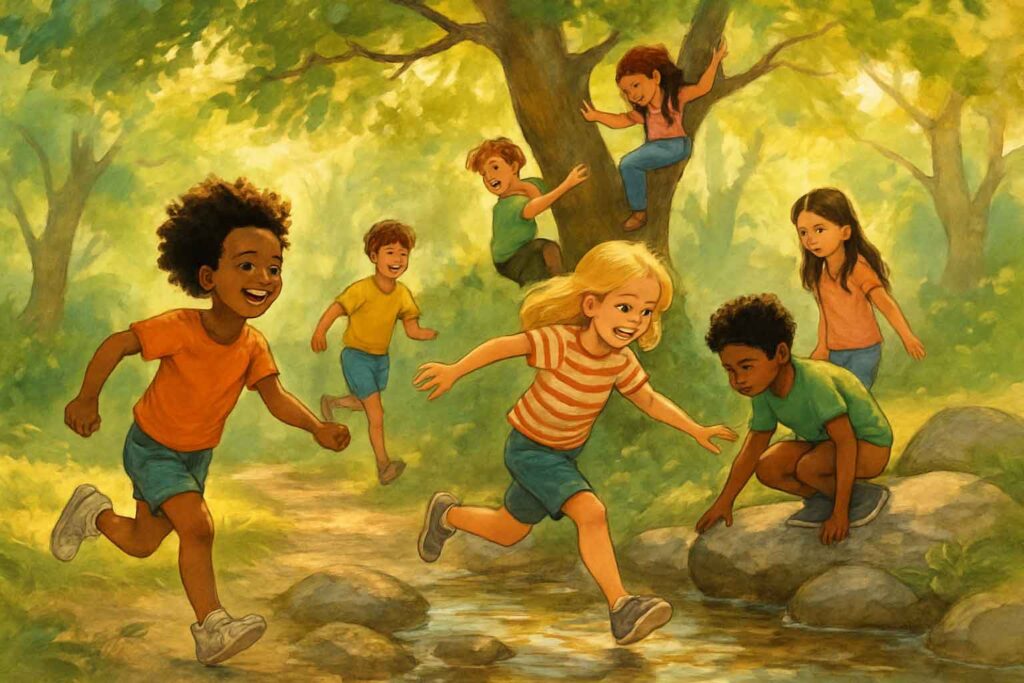Introduction
In an increasingly digital world, where screens often dominate children’s free time, the simple yet profound act of playing outdoors is more crucial than ever. Outdoor play is not merely a recreational activity; it is a fundamental component of healthy child development, offering a unique blend of physical, cognitive, social, and emotional benefits that cannot be replicated indoors. This article will explore the myriad advantages of unstructured outdoor play, highlighting why it is an indispensable part of every child’s growth and how parents and educators can encourage more time spent in nature.
The Multifaceted Benefits of Outdoor Play
Outdoor play provides a rich, dynamic environment that stimulates development across various domains:
1. Physical Development
The most immediate and obvious benefit of outdoor play is its contribution to physical health. The open space and natural elements encourage:
•Gross Motor Skills: Running, jumping, climbing, swinging, and balancing all contribute to the development of large muscle groups, coordination, and agility.
•Cardiovascular Health: Sustained physical activity outdoors helps build stamina and promotes a healthy heart and lungs.
•Strength and Endurance: Activities like climbing trees or navigating uneven terrain build muscle strength and improve overall endurance.
•Reduced Risk of Obesity: Regular outdoor play is a key factor in combating childhood obesity and promoting a healthy weight.
•Improved Sleep: Physical exertion and exposure to natural light can lead to better sleep patterns.
2. Cognitive Development
Nature is the ultimate classroom, offering endless opportunities for cognitive growth:
•Problem-Solving: Children encounter natural obstacles (e.g., how to cross a stream, how to build a fort) that require creative solutions.
•Critical Thinking: Observing natural phenomena, like changing weather or animal behavior, encourages curiosity and scientific inquiry.
•Sensory Exploration: The diverse textures, sounds, smells, and sights of the outdoors stimulate all senses, enhancing sensory processing and perception.
•Risk Assessment: Children learn to evaluate risks and make judgments about their physical capabilities (e.g., how high can I climb, how fast can I run).
•Attention and Focus: Studies suggest that spending time in nature can improve attention spans and reduce symptoms of ADHD in children.
3. Social and Emotional Development
Outdoor environments naturally foster social interaction and emotional regulation:
•Collaboration and Negotiation: Group play in unstructured settings requires children to communicate, share, negotiate roles, and resolve conflicts independently.
•Creativity and Imagination: Natural elements become props for imaginative play (e.g., a stick becomes a sword, a log becomes a pirate ship), fostering creativity and storytelling.
•Self-Confidence and Independence: Successfully navigating outdoor challenges builds a sense of accomplishment and self-reliance.
•Stress Reduction: Exposure to nature has been shown to reduce stress, anxiety, and improve mood in children.
•Connection to Nature: Developing an appreciation for the natural world can lead to environmental stewardship and a sense of wonder.
4. Language and Communication Skills
Outdoor play provides a rich context for language development:
•Descriptive Language: Children use a wider range of vocabulary to describe their observations and experiences in nature.
•Narrative Development: Creating imaginative scenarios and stories during play enhances narrative skills.
•Peer Interaction: The need to coordinate and communicate during group play strengthens conversational abilities.
Encouraging More Outdoor Play
Parents and educators can play a vital role in ensuring children get enough time outdoors:
For Parents:
•Prioritize Unstructured Playtime: Schedule dedicated time for outdoor play, treating it as important as other activities.
•Limit Screen Time: Establish clear boundaries for screen use to free up time for outdoor exploration.
•Provide Access to Nature: Seek out parks, nature trails, local forests, or even just a backyard with natural elements.
•Dress for the Weather: Don’t let rain or cold deter outdoor adventures. Invest in appropriate clothing.
•Be a Role Model: Join your children outdoors. Your enthusiasm is contagious.
•Create an Outdoor Play Space: Even a small balcony or patio can be transformed with plants, water, and loose parts for play.
For Teachers:
•Integrate Outdoor Learning: Take lessons outside whenever possible, whether it’s a nature walk for science or reading under a tree.
•Design Outdoor Play Areas: Create stimulating outdoor spaces with natural elements, loose parts, and opportunities for climbing and exploration.
•Encourage Free Play: Allow for unstructured time where children can direct their own play and explore their interests.
•Educate Parents: Share the benefits of outdoor play with families and provide resources for outdoor activities.
•Embrace Risk (Safely): Allow children to engage in age-appropriate risky play (e.g., climbing, balancing) under supervision, as this builds confidence and risk assessment skills.
Conclusion
Outdoor play is not a luxury but a necessity for optimal child development. It is the original classroom, offering unparalleled opportunities for physical health, cognitive growth, social-emotional well-being, and a deep connection to the natural world. By unplugging and encouraging children to explore the wonders of the outdoors, parents and educators can foster resilient, creative, and well-rounded individuals ready to thrive in an ever-changing world. Let’s reclaim the magic of outdoor play and give our children the gift of nature’s classroom.
